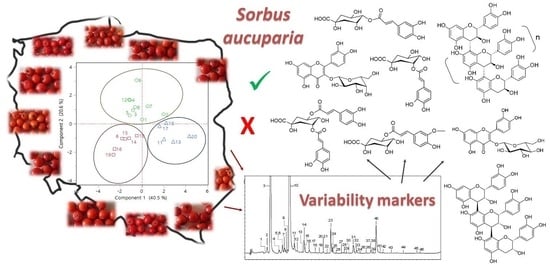Chemometrics-Driven Variability Evaluation of Phenolic Composition, Antioxidant Capacity, and α-Glucosidase Inhibition of Sorbus aucuparia L. Fruits from Poland: Identification of Variability Markers for Plant Material Valorization
Abstract
:1. Introduction
2. Materials and Methods
2.1. Plant Materials
2.2. Extracts Preparation
2.3. Qualitative Profiling
2.4. Quantitative Profiling
2.5. Radical Scavenging Activity
2.6. α-Glucosidase Inhibitory Activity
2.7. Statistical Analyses
3. Results and Discussion
3.1. Qualitative Variability of the Phenolic Composition
3.2. Quantitative Variability of the Phenolic Composition
3.3. The Variation in the Biological Activity Parameters
3.4. The Selection of Variability Markers of Rowanberries Composition and Activity: Chemometric Analysis
4. Conclusions
Supplementary Materials
Author Contributions
Funding
Institutional Review Board Statement
Informed Consent Statement
Data Availability Statement
Acknowledgments
Conflicts of Interest
References
- Räty, M.; Caudullo, G.; de Rigo, D. Sorbus aucuparia in Europe: Distribution, Habitat, Usage and Threats. In European Atlas of Forest Tree Species; San-Miguel-Ayanz, J., de Rigo, D., Caudullo, G., Houston Durrant, T., Mauri, A., Eds.; Publ. Off. EU: Luxembourg, 2016; pp. 176–177. [Google Scholar]
- Batsatsashvili, K.; Mehdiyeva, N.P.; Fayvush, G.; Kikvidze, Z.; Khutsishvili, M.; Maisaia, I.; Sikharulidze, S.; Tchelidze, D.; Aleksanyan, A.; Alizade, V.M.; et al. Sorbus aucuparia L. Sorbus torminalis (L.) Crantz Rosaceae. In Ethnobotany of the Caucasus; Bussmann, R.W., Ed.; Springer: Cham, Switzerland, 2017; pp. 665–672. ISBN 978-3-319-49411-1. [Google Scholar]
- Zlobin, A.A.; Martinson, E.A.; Litvinets, S.G.; Ovechkina, I.A.; Durnev, E.A.; Ovodova, R.G. Pectin Polysaccharides of Rowan Sorbus aucuparia L. Russ. J. Bioorg. Chem. 2012, 38, 702–706. [Google Scholar] [CrossRef]
- Facciola, S. Cornucopia II: A Source Book of Edible Plants; Kampong Publications: Vista, CA, USA, 1998; ISBN 9780962808722. [Google Scholar]
- Rutkowska, M.; Kolodziejczyk-Czepas, J.; Owczarek, A.; Zakrzewska, A.; Magiera, A.; Olszewska, M.A. Novel Insight into Biological Activity and Phytochemical Composition of Sorbus aucuparia L. Fruits: Fractionated Extracts as Inhibitors of Protein Glycation and Oxidative/Nitrative Damage of Human Plasma Components. Food Res. Int. 2021, 147, 110526. [Google Scholar] [CrossRef]
- Boath, A.S.; Stewart, D.; McDougall, G.J. Berry Components Inhibit α-Glucosidase In Vitro: Synergies between Acarbose and Polyphenols from Black Currant and Rowanberry. Food Chem. 2012, 135, 929–936. [Google Scholar] [CrossRef]
- Grussu, D.; Stewart, D.; McDougall, G.J. Berry Polyphenols Inhibit α-Amylase In Vitro: Identifying Active Components in Rowanberry and Raspberry. J. Agric. Food Chem. 2011, 59, 2324–2331. [Google Scholar] [CrossRef]
- Kähkönen, M.P.; Hopia, A.I.; Heinonen, M. Berry Phenolics and Their Antioxidant Activity. J. Agric. Food Chem. 2001, 49, 4076–4082. [Google Scholar] [CrossRef]
- Mlcek, J.; Rop, O.; Jurikova, T.; Sochor, J.; Fisera, M.; Balla, S.; Baron, M.; Hrabe, J. Bioactive Compounds in Sweet Rowanberry Fruits of Interspecific Rowan Crosses. Cent. Eur. J. Biol. 2014, 9, 1078–1086. [Google Scholar] [CrossRef]
- Kylli, P.; Nohynek, L.; Puupponen-Pimiä, R.; Westerlund-Wikström, B.; McDougall, G.; Stewart, D.; Heinonen, M. Rowanberry Phenolics: Compositional Analysis and Bioactivities. J. Agric. Food Chem. 2010, 58, 11985–11992. [Google Scholar] [CrossRef] [PubMed]
- Olszewska, M.A.; Michel, P. Antioxidant Activity of Inflorescences, Leaves and Fruits of Three Sorbus Species in Relation to Their Polyphenolic Composition. Nat. Prod. Res. 2009, 23, 1507–1521. [Google Scholar] [CrossRef] [PubMed]
- Aladedunye, F.; Matthäus, B. Phenolic Extracts from Sorbus aucuparia (L.) and Malus baccata (L.) Berries: Antioxidant Activity and Performance in Rapeseed Oil during Frying and Storage. Food Chem. 2014, 159, 273–281. [Google Scholar] [CrossRef] [PubMed]
- Bobinaitė, R.; Grootaert, C.; Van Camp, J.; Šarkinas, A.; Liaudanskas, M.; Žvikas, V.; Viškelis, P.; Rimantas Venskutonis, P. Chemical Composition, Antioxidant, Antimicrobial and Antiproliferative Activities of the Extracts Isolated from the Pomace of Rowanberry (Sorbus aucuparia L.). Food Res. Int. 2020, 136, 109310. [Google Scholar] [CrossRef]
- Bujor, A.; Miron, A.; Luca, S.V.; Skalicka-Wozniak, K.; Silion, M.; Ancuceanu, R.; Dinu, M.; Girard, C.; Demougeot, C.; Totoson, P. Metabolite Profiling, Arginase Inhibition and Vasorelaxant Activity of Cornus mas, Sorbus aucuparia and Viburnum opulus Fruit Extracts. Food Chem. Toxicol. 2019, 133, 110764. [Google Scholar] [CrossRef]
- Gil-Izquierdo, A.; Mellenthin, A. Identification and Quantitation of Flavonols in Rowanberry (Sorbus aucuparia L.) Juice. Eur. Food Res. Technol. 2001, 213, 12–17. [Google Scholar] [CrossRef]
- Mikulic-Petkovsek, M.; Krska, B.; Kiprovski, B.; Veberic, R. Bioactive Components and Antioxidant Capacity of Fruits from Nine Sorbus Genotypes. J. Food Sci. 2017, 82, 647–658. [Google Scholar] [CrossRef]
- Zymone, K.; Raudone, L.; Raudonis, R.; Marksa, M.; Ivanauskas, L.; Janulis, V. Phytochemical Profiling of Fruit Powders of Twenty Sorbus L. Cultivars. Molecules 2018, 23, 2593. [Google Scholar] [CrossRef]
- Sołtys, A.; Galanty, A.; Podolak, I. Ethnopharmacologically Important but Underestimated Genus Sorbus: A Comprehensive Review. Phytochem. Rev. 2020, 19, 491–526. [Google Scholar] [CrossRef]
- Khalid, M.; Saeed-ur-Rahman; Bilal, M.; Huang, D.F. Role of Flavonoids in Plant Interactions with the Environment and against Human Pathogens—A Review. J. Integr. Agric. 2019, 18, 211–230. [Google Scholar] [CrossRef]
- Ncube, B.; Finnie, J.F.; Van Staden, J. Quality from the Field: The Impact of Environmental Factors as Quality Determinants in Medicinal Plants. S. Afr. J. Bot. 2012, 82, 11–20. [Google Scholar] [CrossRef]
- Mierziak, J.; Kostyn, K.; Kulma, A. Flavonoids as Important Molecules of Plant Interactions with the Environment. Molecules 2014, 19, 16240–16265. [Google Scholar] [CrossRef]
- Muyumba, N.W.; Mutombo, S.C.; Sheridan, H.; Nachtergael, A.; Duez, P. Quality Control of Herbal Drugs and Preparations: The Methods of Analysis, Their Relevance and Applications. Talanta Open 2021, 4, 100070. [Google Scholar] [CrossRef]
- Ożarowski, A.; Jaroniewski, W. Rośliny Lecznicze i Ich Praktyczne Zastosowanie; Wydawnictwo Instytutu Wydawniczego Związków Zawodowych: Warszawa, Poland, 1987; pp. 179–180. [Google Scholar]
- Rocznik Meteorologiczny. Instytut Meteorologii i Gospodarki Wodnej—Państwowy Instytut Badawczy; Szokalska, A., Ed.; Biuro Badań nad Klimatem Polski, Wydział Baz Danych: Warszawa, Poland, 2019; pp. 1–358. [Google Scholar]
- Olszewska, M.A.; Presler, A.; Michel, P. Profiling of Phenolic Compounds and Antioxidant Activity of Dry Extracts from the Selected Sorbus Species. Molecules 2012, 17, 3093–3113. [Google Scholar] [CrossRef]
- Fu, R.; Zhang, Y.; Guo, Y.; Liu, F.; Chen, F. Determination of Phenolic Contents and Antioxidant Activities of Extracts of Jatropha curcas L. Seed Shell, a by-Product, a New Source of Natural Antioxidant. Ind. Crops Prod. 2014, 58, 265–270. [Google Scholar] [CrossRef]
- Marchelak, A.; Owczarek, A.; Rutkowska, M.; Michel, P.; Kolodziejczyk-Czepas, J.; Nowak, P.; Olszewska, M.A. New Insights into Antioxidant Activity of Prunus spinosa Flowers: Extracts, Model Polyphenols and Their Phenolic Metabolites in Plasma towards Multiple in Vivo-Relevant Oxidants. Phytochem. Lett. 2019, 30, 288–295. [Google Scholar] [CrossRef]
- Kim, Y.-M.; Jeong, Y.-K.; Wang, M.-H.; Lee, W.-Y.; Rhee, H.-I. Inhibitory Effect of Pine Extract on α-Glucosidase Activity and Postprandial Hyperglycemia. Nutrition 2005, 21, 756–761. [Google Scholar] [CrossRef]
- Clifford, M.N.; Johnston, K.L.; Knight, S.; Kuhnert, N. Hierarchical Scheme for LC-MSn Identification of Chlorogenic Acids. J. Agric. Food Chem. 2003, 51, 2900–2911. [Google Scholar] [CrossRef]
- Clifford, M.N.; Knight, S.; Kuhnert, N. Discriminating between the Six Isomers of Dicaffeoylquinic Acid by LC-MS N. J. Agric. Food Chem. 2005, 53, 3821–3832. [Google Scholar] [CrossRef]
- Jaiswal, R.; Kuhnert, N. Identification and Characterization of Five New Classes of Chlorogenic Acids in Burdock (Arctium lappa L.) Roots by Liquid Chromatography/Tandem Mass Spectrometry. Food Funct. 2011, 2, 63–71. [Google Scholar] [CrossRef]
- Wu, Z.-J.; Ma, X.-L.; Fang, D.-M.; Qi, H.-Y.; Ren, W.-J.; Zhang, G.-L. Analysis of Caffeic Acid Derivatives from Osmanthus yunnanensis Using Electrospray Ionization Quadrupole Time-of-Flight Mass Spectrometry. Eur. J. Mass Spectrom. 2009, 15, 415–429. [Google Scholar] [CrossRef]
- Šavikin, K.P.; Zdunić, G.M.; Krstić-Milošević, D.B.; Šircelj, H.J.; Stešević, D.D.; Pljevljakušić, D.S. Sorbus aucuparia and Sorbus aria as a Source of Antioxidant Phenolics, Tocopherols, and Pigments. Chem. Biodivers. 2017, 14, e1700329. [Google Scholar] [CrossRef]
- Poljak, I.; Vahčić, N.; Liber, Z.; Tumpa, K.; Pintar, V.; Zegnal, I.; Vidaković, A.; Valković, B.; Kajba, D.; Idžojtić, M. Morphological and Chemical Diversity and Antioxidant Capacity of the Service Tree (Sorbus domestica L.) Fruits from Two Eco-geographical Regions. Plants 2021, 10, 1691. [Google Scholar] [CrossRef]
- Rutkowska, M.; Dubicka, M.; Olszewska, M.A. Comparison of Phenolic Profile and in Vitro Antioxidant Capacity of Sorbus domestica L. Leaf Samples from Poland and Croatia. Acta Biol. Cracoviensia Ser. Bot. 2019, 61, 19–29. [Google Scholar] [CrossRef]
- Popović, Z.; Matić, R.; Bajić-Ljubičić, J.; Tešević, V.; Bojović, S. Geographic Variability of Selected Phenolic Compounds in Fresh Berries of Two Cornus Species. Trees—Struct. Funct. 2018, 32, 203–214. [Google Scholar] [CrossRef]
- Mattila, P.H.; Hellström, J.; Karhu, S.; Pihlava, J.M.; Veteläinen, M. High Variability in Flavonoid Contents and Composition between Different North-European Currant (Ribes spp.) Varieties. Food Chem. 2016, 204, 14–20. [Google Scholar] [CrossRef]
- Alirezalu, A.; Salehi, P.; Ahmadi, N.; Sonboli, A.; Aceto, S.; Maleki, H.H.; Ayyari, M. Flavonoids Profile and Antioxidant Activity in Flowers and Leaves of Hawthorn Species (Crataegus spp.) from Different Regions of Iran. Int. J. Food Prop. 2018, 21, 452–470. [Google Scholar] [CrossRef]
- Falcone Ferreyra, M.L.; Rius, S.P.; Casati, P. Flavonoids: Biosynthesis, Biological Functions, and Biotechnological Applications. Front. Plant Sci. 2012, 3, 222. [Google Scholar] [CrossRef] [PubMed]
- Zoratti, L.; Karppinen, K.; Escobar, A.L.; Häggman, H.; Jaakola, L. Light-Controlled Flavonoid Biosynthesis in Fruits. Front. Plant Sci. 2014, 5, 534. [Google Scholar] [CrossRef]
- Prinsloo, G.; Nogemane, N. The Effects of Season and Water Availability on Chemical Composition, Secondary Metabolites and Biological Activity in Plants. Phytochem. Rev. 2018, 17, 889–902. [Google Scholar] [CrossRef]
- Šamec, D.; Karalija, E.; Šola, I.; Vujčić Bok, V.; Salopek-Sondi, B. The Role of Polyphenols in Abiotic Stress Response: The Influence of Molecular Structure. Plants 2021, 10, 118. [Google Scholar] [CrossRef] [PubMed]
- Downey, M.O.; Harvey, J.S.; Robinson, S.P. The Effect of Bunch Shading on Berry Development and Flavonoid Accumulation in Shiraz Grapes. Aust. J. Grape Wine Res. 2004, 10, 55–73. [Google Scholar] [CrossRef]
- Engwa, G.A. Free Radicals and the Role of Plant Phytochemicals as Antioxidants Against Oxidative Stress-Related Diseases. Phytochem.—Source Antioxid. Role Dis. Prev. 2018, 7, 49–74. [Google Scholar] [CrossRef]
- Lipinski, B. Hydroxyl Radical and Its Scavengers in Health and Disease. Oxid. Med. Cell. Longev. 2011, 2011, 809696. [Google Scholar] [CrossRef]
- Hasbal, G.; Yilmaz Ozden, T.; Can, A. In Vitro Antidiabetic Activities of Two Sorbus Species. Eur. J. Biol. 2017, 76, 57–60. [Google Scholar] [CrossRef]
- Wei, J.; Zhang, G.; Zhang, X.; Gao, J.; Zhou, Z.; Fan, J. Polyphenols from Sorbus aucuparia Ameliorate Insulin Resistance and Metabolic Disorders in Diabetic Mice. Curr. Top. Nutraceutical Res. 2016, 14, 227–233. [Google Scholar]
- Rutkowska, M.; Olszewska, M.A.; Kolodziejczyk-Czepas, J.; Nowak, P.; Owczarek, A. Sorbus domestica Leaf Extracts and Their Activity Markers: Antioxidant Potential and Synergy Effects in Scavenging Assays of Multiple Oxidants. Molecules 2019, 24, 2289. [Google Scholar] [CrossRef]
- Kundzewicz, Z.W.; Matczak, P. Climate Change Regional Review: Poland. WIREs Clim. Change 2012, 3, 297–311. [Google Scholar] [CrossRef]
- Zhang, B.; Xia, T.; Duan, W.; Zhang, Z.; Li, Y.; Fang, B.; Xia, M.; Wang, M. Effects of Organic Acids, Amino Acids and Phenolic Compounds on Antioxidant Characteristic of Zhenjiang Aromatic Vinegar. Molecules 2019, 24, 3799. [Google Scholar] [CrossRef] [PubMed]

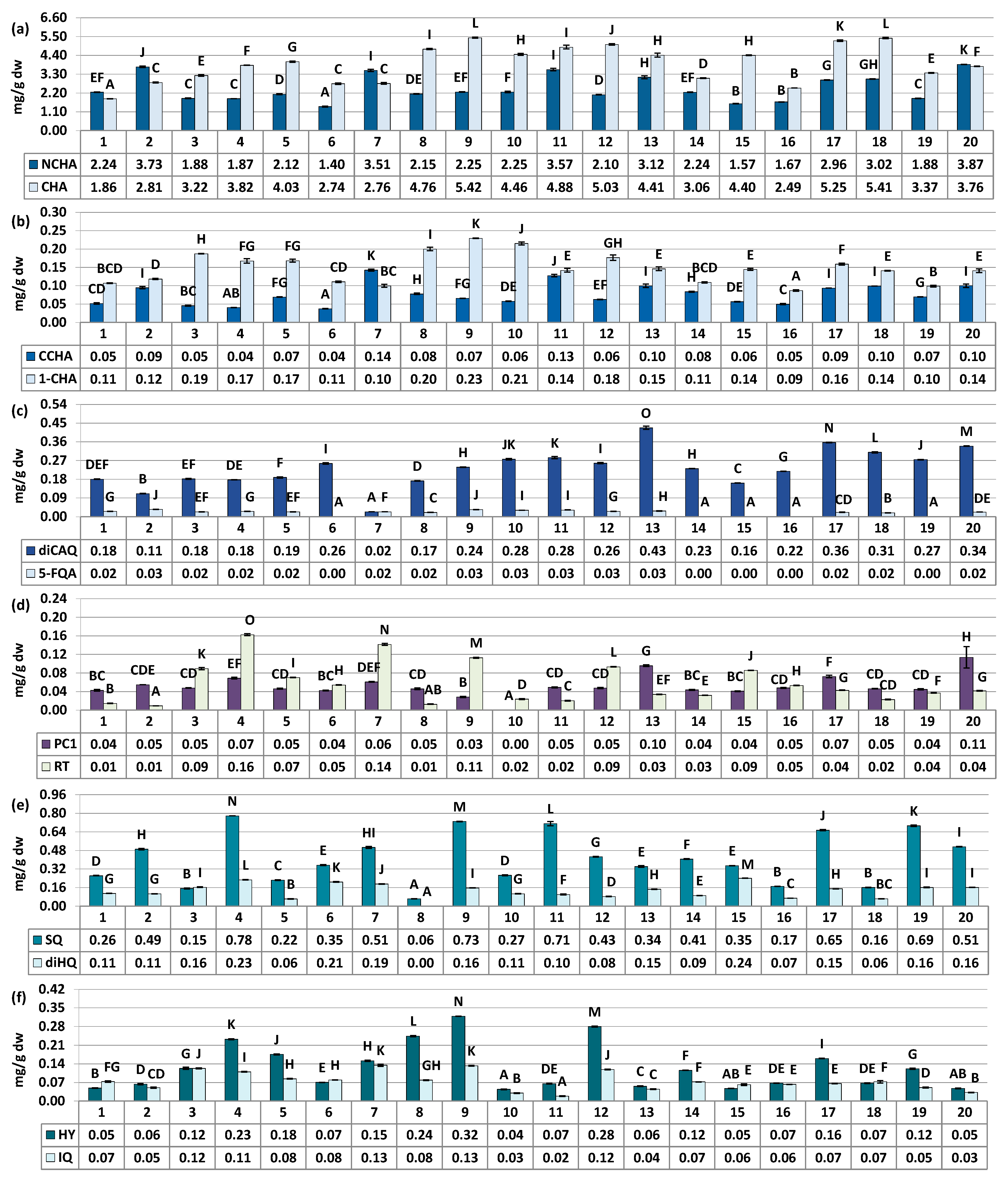

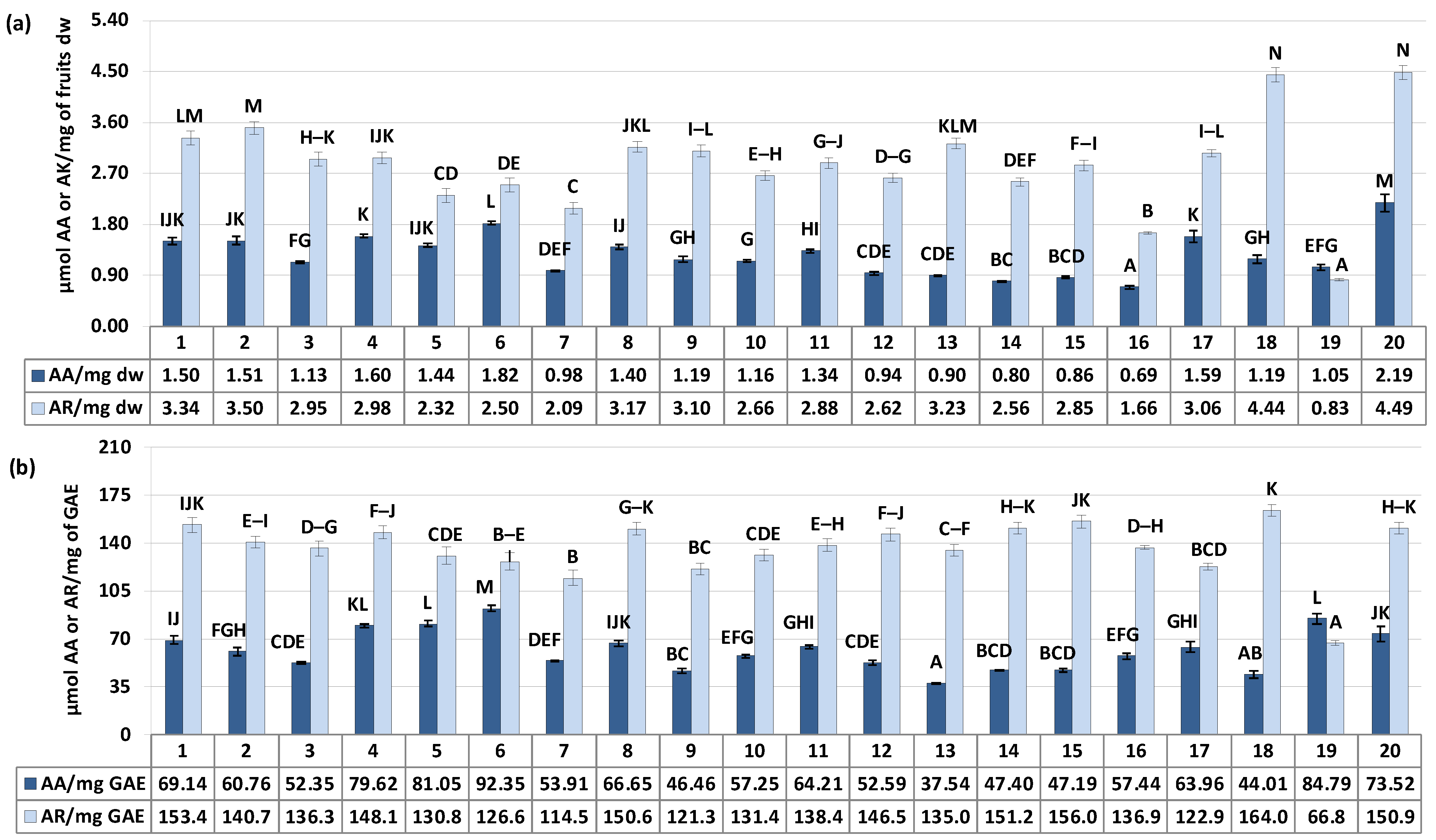
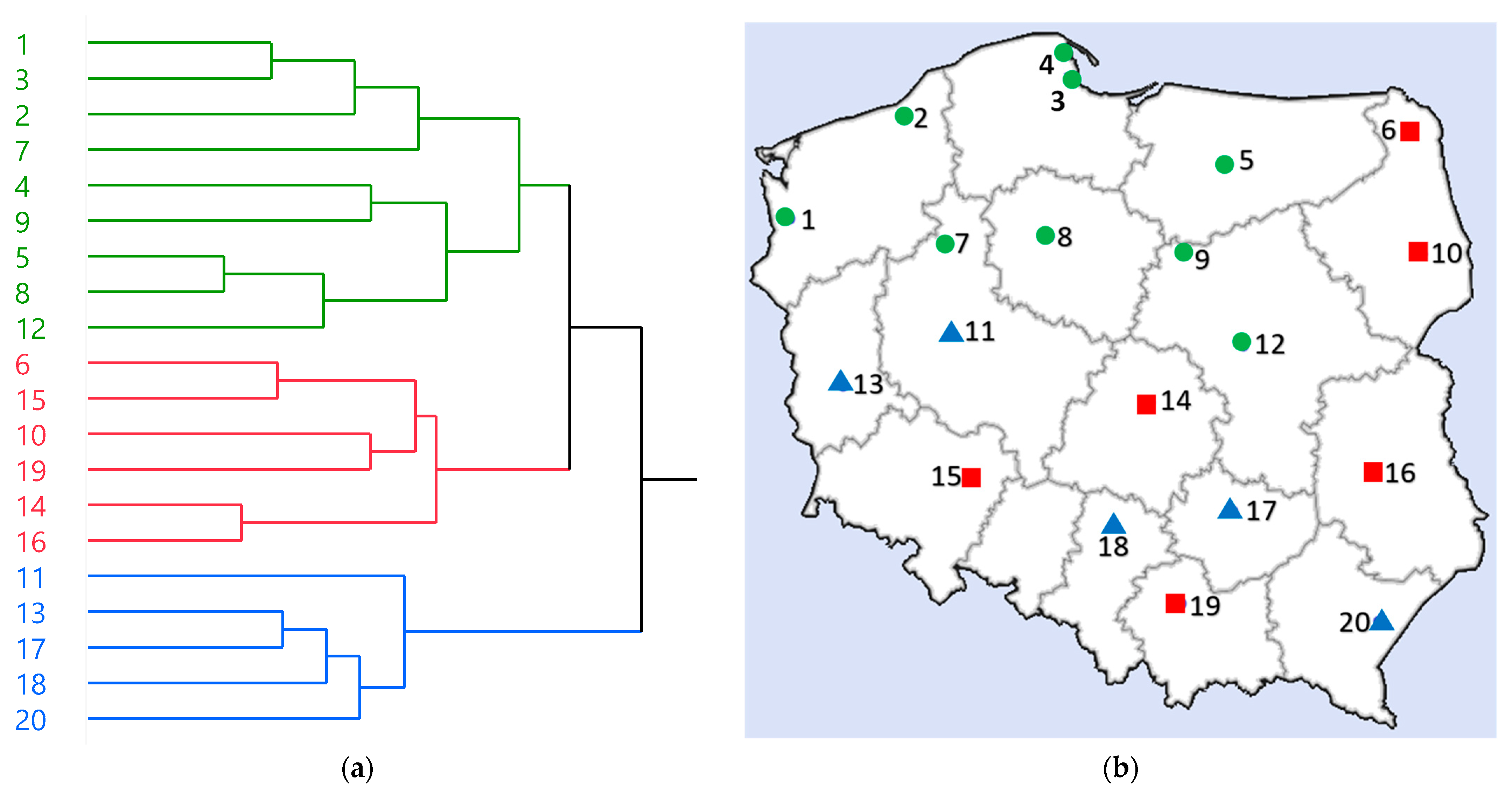
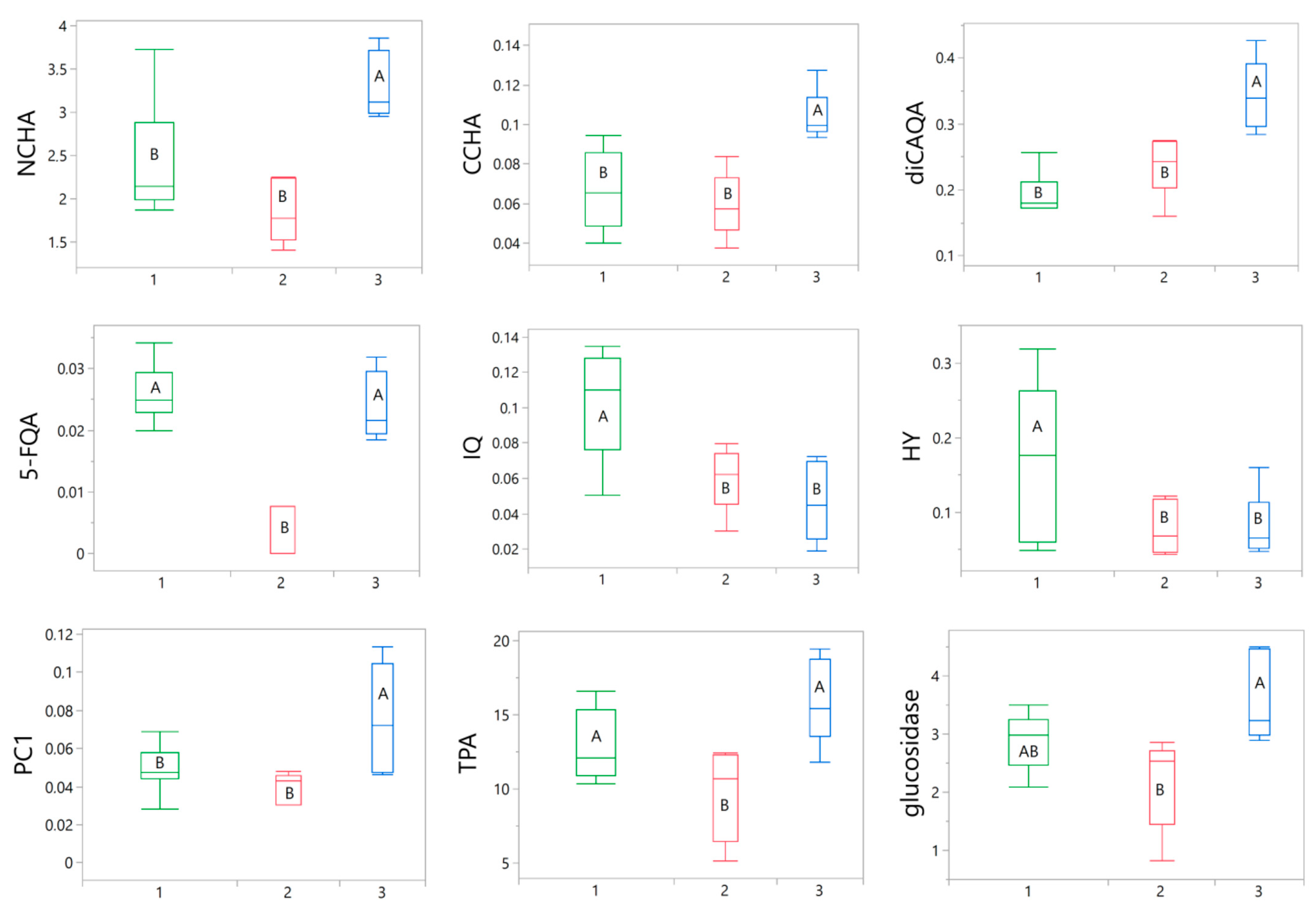
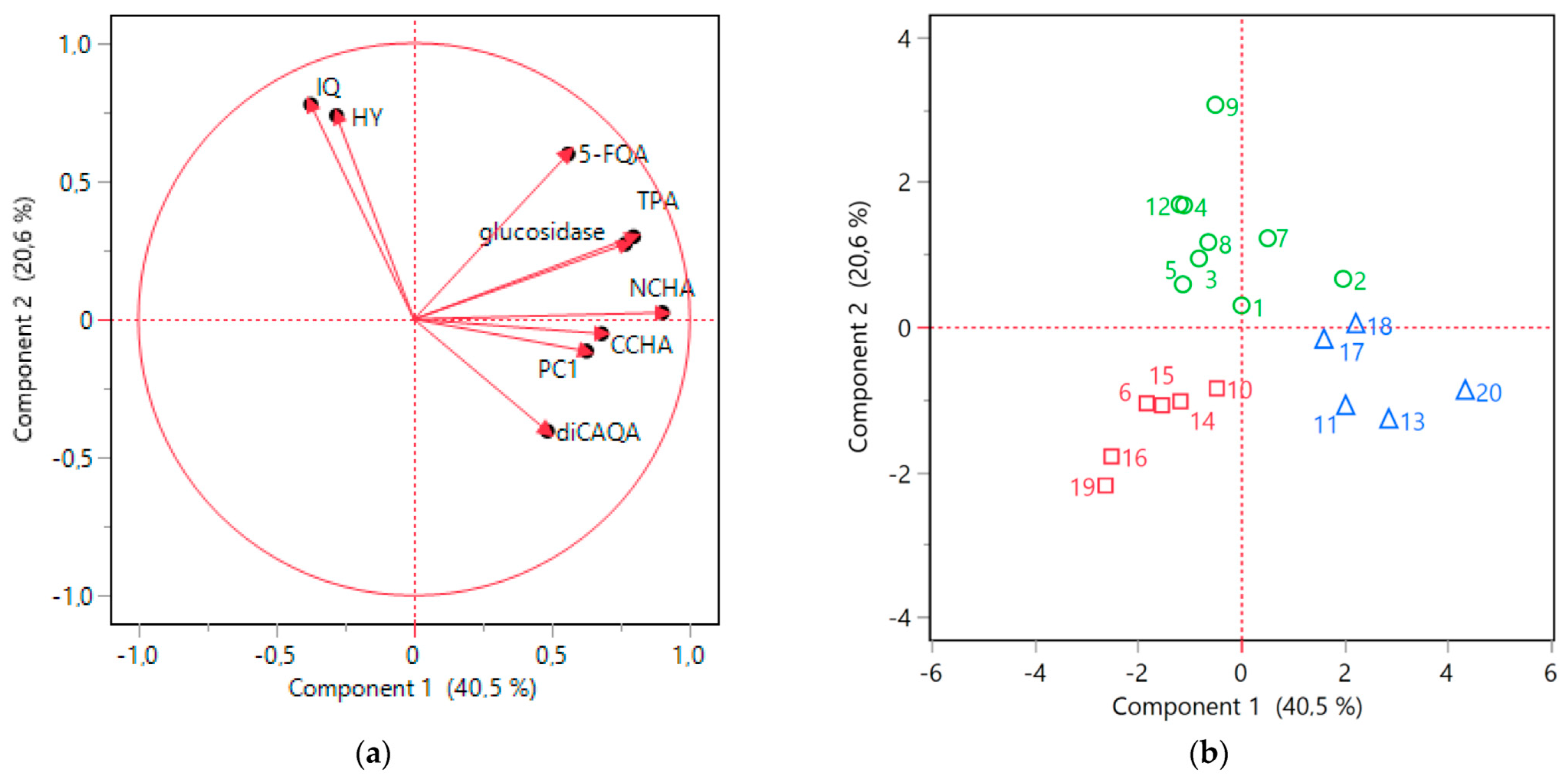
| Sample No. | Location | Voucher Specimen | Average Air Temperature (°C) * | Average Air Humidity (%) * |
|---|---|---|---|---|
| 1 | Szczecin (14°34′ E, 53°26′ N), NH | KFG/HB/11019/SAUC/F/ZM | 16.2 | 69 |
| 2 | Koszalin (16°11′ E, 54°11′ N), NH | KFG/HB/12019/SAUC/F/ZM | 15.4 | 72 |
| 3 | Gdynia (18°32′ E, 54°32′ N), NH | KFG/HB/13019/SAUC/F/ZM | 15.3 | 74 |
| 4 | Wladyslawowo (18°24′ E, 54°48′ N), NH | KFG/HB/14019/SAUC/F/ZM | 14.9 | 77 |
| 5 | Olsztyn (16°07′ E, 52°07′ N), NH | KFG/HB/15019/SAUC/F/ZM | 15.3 | 69 |
| 6 | Suwalki (22°56′ E, 54°06′ N), NH | KFG/HB/16019/SAUC/F/ZM | 14.9 | 67 |
| 7 | Pila (16°45′ E, 53°10′ N), NH | KFG/HB/17019/SAUC/F/ZM | 16.4 | 66 |
| 8 | Bydgoszcz (18°00′ E, 53°07′ N), CT, Garden of medicinal and cosmetic plants, Collegium Medicum | KFG/HB/18019/SAUC/F/ZM | 16.4 | 66 |
| 9 | Zielun (19°51′ E, 53°10′ N), NH | KFG/HB/19019/SAUC/F/ZM | 15.9 | 68 |
| 10 | Bialystok (23°10′ E, 53°08′ N), NH | KFG/HB/20019/SAUC/F/ZM | 15.1 | 71 |
| 11 | Poznan (16°55′ E, 52°25′ N), NH | KFG/HB/21019/SAUC/F/ZM | 17.0 | 63 |
| 12 | Smoszewo (20°30′ E, 52°26′ N), NH | KFG/HB/22019/SAUC/F/ZM | 17.1 | 64 |
| 13 | Zielona Gora (15°30′ E, 51°56′ N), NH | KFG/HB/23019/SAUC/F/ZM | 16.8 | 63 |
| 14 | Lodz (19°24′ E, 51°48′ N), NH | KFG/HB/24019/SAUC/F/ZM | 16.3 | 66 |
| 15 | Wroclaw (17°02′ E, 51°07′ N), NH | KFG/HB/25019/SAUC/F/ZM | 17.2 | 66 |
| 16 | Lublin (22°34′ E, 51°14′ N), NH | KFG/HB/26019/SAUC/F/ZM | 15.9 | 70 |
| 17 | Kielce (20°36′ E, 50°52′ N), CT, Geopark—Botanical Garden | KFG/HB/27019/SAUC/F/ZM | 15.9 | 72 |
| 18 | Czestochowa (19°07′ E, 50°48′ N), NH | KFG/HB/28019/SAUC/F/ZM | 16.3 | 69 |
| 19 | Krakow (19°57′ E, 50°03′ N), NH | KFG/HB/29019/SAUC/F/ZM | 15.9 | 71 |
| 20 | Bolestraszyce (22°51′ E, 49°49′ N), CT, Arboretum and Department of Physiography | KFG/HB/30019/SAUC/F/ZM | 16.4 | 73 |
| Analyte | Rt (min) | UV λmax (nm) | [M–H]− (m/z) | MS/MS Fragmentation | Sample No. | |
|---|---|---|---|---|---|---|
| 1 | caffeic acid derivative | 4.9 | 320 | 407 | 389(100), 295(21), 277(19), 179(36) | all samples |
| 2 | caffeic acid derivative | 5.6 | 320 | 407 | 389(100), 295(22), 277(33), 235(4), 179(48) | all samples |
| 3 | 3-O-caffeoylquinic acid (neochlorogenic acid, NCHA) a | 6.3 | 325 | 353 | 191(100), 179(48), 135(2) | all samples |
| 4 | caffeoylquinic acid derivative | 8.5 | 325 | 517 | 353(100), 191(47) | all samples |
| 5 | caffeoylquinic acid derivative | 9.2 | 325 | 517 | 353(100), 335(50), 191(38), 179(2) | all samples |
| 6 | p-coumaroylquinic acid isomer | 9.4 | 310 | 337 | 191(9), 163(100) | all samples |
| 7 | caffeic acid derivative | 10.1 | 320 | 629 | 471(86), 359(9), 291(100), 179(9) | all samples |
| 8 | vanilic acid hexose conjugate | 10.3 | 284 | 329 | 283(15), 167(100) | all samples |
| 9 | amygdalin a | 10.8 | 210 | 456 | 456(100), 323(5), 323(100) b, 221(5) b | all samples |
| 10 | 5-O-caffeoylquinic acid (chlorogenic acid, CHA) a | 11.3 | 325 | 353 | 191(100), 179(4) | all samples |
| 11 | 4-O-caffeoylquinic acid (cryptochlorogenic acid, CCHA)a | 12.6 | 325 | 353 | 191(100), 179(57), 173(87), 215(3) | all samples |
| 12 | procyanidin trimer B-type | 13.3 | 279 | 865 | 713(36), 695(100), 577(67), 543(38), 407(32), 287(25), 695(100) b,543(62) b, 407(100) b | 1, 3, 4, 16, 17, 20 |
| 13 | vanilic acid hexose conjugate | 14.5 | 284 | 329 | 269(14), 191(100), 167(28) | all samples |
| 14 | 1-O-caffeoylquinic acid (1-CHA) | 15.1 | 325 | 353 | 215(31), 191(100), 179(5) | all samples |
| 15 | procyanidin B-2 a | 15.2 | 279 | 577 | 451(17), 425(100), 407(32), 289(11) | all samples |
| 16 | (-)-epicatechin a | 16.5 | 279 | 289 | 245(100), 205(25) | all samples |
| 17 | 5-caffeoylshikimic acid | 16.5 | 325 | 335 | 291(10), 179(100), 161(34), 135(25) | all samples |
| 18 | 3-caffeoylshikimic acid | 17.8 | 325 | 335 | 179(100), 161(2), 135(17) | all samples |
| 19 | procyanidin tetramer B-type | 18.3 | 279 | 1153 | 1027(100), 983(42), 863(44), 739(40), 577(38), 449(18) | 2, 3, 4, 5, 7, 8, 10, 11, 12, 13, 15, 16, 17, 18, 19, 20 |
| 20 | 3-O-feruloylquinic acid | 19.7 | 325 | 367 | 335(12), 193(12), 161(100), 135(22) | all samples |
| 21 | caffeoylshikimic acid | 20.0 | 325 | 335 | 179(11), 161(100), 135(73) | all samples |
| 22 | procyanidin C-1 (PC1) a | 20.8 | 279 | 865 | 739(47), 695(100), 577(72), 451(36), 407(53), 287(22) | all samples |
| 23 | quercetin 3-O-β-sophoroside (SQ) a | 21.8 | 350 | 625 | 579(4), 463(27), 445(42), 355(12), 301(100) b | all samples |
| 24 | 5-O-feruloylquinic acid (5-FQA) | 22.3 | 325 | 367 | 335(3), 191(31), 179(100), 161(9), 135(32) | all samples |
| 25 | quercetin O-dihexoside (diHQ) | 22.6 | 255, 352 | 625 | 579(16), 463(35), 445(53), 355(12), 301(100) b, 151(45) b | all samples |
| 26 | procyanidin tetramer B-type | 23.2 | 279 | 1153 | 1027(62), 983(75), 863(73), 739(45), 575(50), 449(13) | all samples |
| 27 | quercetin-hexoside-pentoside | 24.8 | 253,353 | 595 | 463(20), 343(22) b, 301(100) b | 1, 2, 4, 6, 7, 9, 10, 11, 12, 14, 16, 17, 19, 20 |
| 28 | kaempferol O-dihexoside | 25.2 | 266, 343 | 609 | 429(38), 285(100) | 2, 4, 6, 7, 9, 11, 13, 14, 15, 17, 19, 20 |
| 29 | procyanidin trimer B-type | 26.0 | 279 | 865 | 713(35), 695(100), 577(13), 289(5), 695(100) b, 543(82) b, 425(74) b, 407(53) b | all samples |
| 30 | cinchonain I isomer | 26.5 | 283 | 451 | 341(100), 217(3) | 2, 3, 4, 5, 7, 8, 9, 10, 11, 12, 13, 14, 15, 16, 17, 18, 19,20 |
| 31 | quercetin 3-O-β-D-galactoside (hyperoside, HY) a | 27.5 | 254, 353 | 463 | 301(100) | all samples |
| 32 | quercetin 3-O-β-D-(6′′-O-α-L-rhamnosyl)-glucoside (rutin, RT) a | 28.0 | 256, 355 | 609 | 301(100) | all samples |
| 33 | quercetin 3-O-β-D-glucoside (isoquercitrin, IQ) a | 28.7 | 256, 353 | 463 | 301(100) | all samples |
| 34 | procyanidin tetramer B-type | 29.3 | 279 | 1153 | 983(40), 863(35), 739(18), 577(16), 507(13), 449(25) | all samples |
| 35 | procyanidin tetramer B-type | 30.6 | 279 | 1153 | 863(63), 771(59), 739(37), 577(100), 451(17), 407(18) | all samples |
| 36 | kaempferol-hexoside | 30.8 | 265, 350 | 447 | 419(4), 327(20), 285(100) | 4, 5, 7, 8, 9, 12, 13, 14, 17 |
| 37 | quercetin-malonyl-hexoside | 32.3 | 255,355 | 549 | 463(41), 301(100) | 1, 2, 3, 4, 5, 6, 7, 9, 10, 12, 14, 16, 17, 18, 19, 20 |
| 38 | kaempferol-hexoside | 32.7 | 275, 350 | 447 | 327(14), 285(100) | 1, 2, 3, 4, 5, 6, 7, 8, 9, 11, 12, 13, 14, 15, 16, 17, 18, 19 |
| 39 | cinchonain I isomer | 32.9 | 280 | 451 | 341(100) | 1, 3, 5, 6, 10, 14, 15, 16, 17, 18, 20 |
| 40 | 3,5-O-dicaffeoylquinic acid (diCAQA) | 33.3 | 325 | 515 | 353(100), 191(3), 179(3), 191(100) b, 179(23) b | all samples |
| 41 | procyanidin tetramer B-type | 34.0 | 279 | 1153 | 863(52), 739(27), 577(67), 407(16) | all samples |
| 42 | kaempferol-acetyl-hexoside | 35.7 | 275, 350 | 489 | 447(9), 327(7), 285(100) | 4, 7, 9, 12, 14, 17 |
| 43 | kaempferol-acetyl-hexoside | 37.2 | 275, 350 | 489 | 285(100) | 1, 2, 3, 4, 5, 6, 7, 9, 12, 14, 16, 17, 18 |
| 44 | cinchonain I isomer | 40.6 | 280 | 451 | 341(100), 289(5) | all samples |
| 45 | quercetin (QU) a | 43.8 | 268, 364 | 301 | 301(100) | 4, 5, 7, 9, 10, 12, 14, 16, 17, 20 |
| 46 | quercetin-glucuronide-hexoside | 44.7 | 255, 355 | 639 | 463(100), 301(33) | 1, 6, 17 |
| Phenolic Groups: | Means ± SD (mg/g dw) | CV (%) | Individual Compounds: | Means ± SD (mg/g dw) | CV (%) |
|---|---|---|---|---|---|
| TPC | 20.75 ± 4.49 | 21.62 | NCHA | 2.47 ± 0.76 | 30.79 |
| TPH | 8.01 ± 1.64 | 20.44 | CHA | 3.90 ± 1.07 | 27.46 |
| THCA | 7.05 ± 1.52 | 21.51 | CCHA | 0.08 ± 0.03 | 37.51 |
| TCHA | 6.83 ± 1.48 | 21.63 | 1-CHA | 0.15 ± 0.04 | 27.48 |
| TCFA | 0.22 ± 0.06 | 25.62 | diCAQA | 0.23 ± 0.09 | 38.94 |
| TFL | 0.90 ± 0.39 | 43.59 | 5-FQA | 0.02 ± 0.01 | 63.39 |
| TPA | 12.81 ± 3.54 | 27.63 | PC1 | 0.05 ± 0.02 | 44.97 |
| TLPA | 0.06 ± 0.02 | 36.30 | RT | 0.06 ± 0.04 | 75.87 |
| SQ | 0.41 ± 0.22 | 52.44 | |||
| diHQ | 0.13 ± 0.06 | 47.27 | |||
| HY | 0.13 ± 0.09 | 68.15 | |||
| IQ | 0.07 ± 0.03 | 45.48 | |||
Disclaimer/Publisher’s Note: The statements, opinions and data contained in all publications are solely those of the individual author(s) and contributor(s) and not of MDPI and/or the editor(s). MDPI and/or the editor(s) disclaim responsibility for any injury to people or property resulting from any ideas, methods, instructions or products referred to in the content. |
© 2023 by the authors. Licensee MDPI, Basel, Switzerland. This article is an open access article distributed under the terms and conditions of the Creative Commons Attribution (CC BY) license (https://creativecommons.org/licenses/by/4.0/).
Share and Cite
Rutkowska, M.; Owczarek-Januszkiewicz, A.; Magiera, A.; Gieleta, M.; Olszewska, M.A. Chemometrics-Driven Variability Evaluation of Phenolic Composition, Antioxidant Capacity, and α-Glucosidase Inhibition of Sorbus aucuparia L. Fruits from Poland: Identification of Variability Markers for Plant Material Valorization. Antioxidants 2023, 12, 1967. https://doi.org/10.3390/antiox12111967
Rutkowska M, Owczarek-Januszkiewicz A, Magiera A, Gieleta M, Olszewska MA. Chemometrics-Driven Variability Evaluation of Phenolic Composition, Antioxidant Capacity, and α-Glucosidase Inhibition of Sorbus aucuparia L. Fruits from Poland: Identification of Variability Markers for Plant Material Valorization. Antioxidants. 2023; 12(11):1967. https://doi.org/10.3390/antiox12111967
Chicago/Turabian StyleRutkowska, Magdalena, Aleksandra Owczarek-Januszkiewicz, Anna Magiera, Mateusz Gieleta, and Monika A. Olszewska. 2023. "Chemometrics-Driven Variability Evaluation of Phenolic Composition, Antioxidant Capacity, and α-Glucosidase Inhibition of Sorbus aucuparia L. Fruits from Poland: Identification of Variability Markers for Plant Material Valorization" Antioxidants 12, no. 11: 1967. https://doi.org/10.3390/antiox12111967
APA StyleRutkowska, M., Owczarek-Januszkiewicz, A., Magiera, A., Gieleta, M., & Olszewska, M. A. (2023). Chemometrics-Driven Variability Evaluation of Phenolic Composition, Antioxidant Capacity, and α-Glucosidase Inhibition of Sorbus aucuparia L. Fruits from Poland: Identification of Variability Markers for Plant Material Valorization. Antioxidants, 12(11), 1967. https://doi.org/10.3390/antiox12111967





